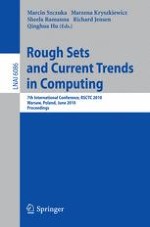2010 | Buch
Rough Sets and Current Trends in Computing
7th International Conference, RSCTC 2010, Warsaw, Poland, June 28-30,2010. Proceedings
herausgegeben von: Marcin Szczuka, Marzena Kryszkiewicz, Sheela Ramanna, Richard Jensen, Qinghua Hu
Verlag: Springer Berlin Heidelberg
Buchreihe : Lecture Notes in Computer Science
